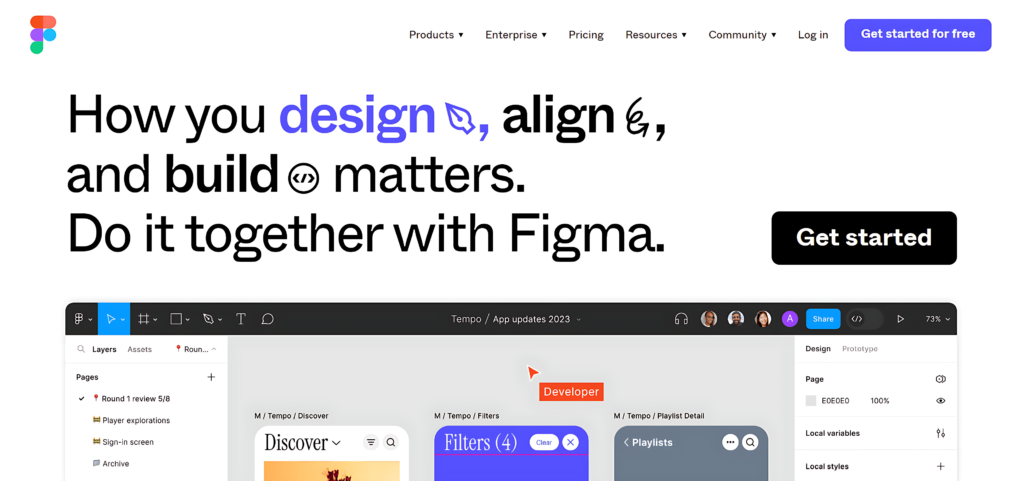In the expansive world of digital design, having the right tools like Figma or Canva at your disposal is paramount. Among the multitude of design platforms, two names stand out prominently: Figma and Canva. Both are widely acclaimed and have their own unique features and capabilities. In this detailed article, we will conduct an in-depth comparison of Figma and Canva to determine which of these design tools reigns supreme and why they might outshine other alternatives in the market.

Table of Contents
Figma: The Collaborative Design Platform
Figma is a cloud-based design tool that facilitates collaborative work in real-time. It is renowned for its versatility, allowing designers to create a wide range of designs, from user interfaces for websites and applications to marketing materials and social media graphics. Here’s why Figma stands out in the competitive design tool landscape:
1. Real-time Collaboration:
One of Figma’s standout features is its ability to allow multiple users to work on a design project simultaneously. Changes are visible in real-time, enhancing collaboration, and streamlining the design process for teams, irrespective of their physical locations.
2. Cross-platform Functionality:
This tool operates on the cloud, making it accessible across various platforms and devices. Whether you’re using a Windows PC, a Mac, or even a tablet, This tool ensures a seamless design experience without the need for high-end hardware.
3. Auto Layout and Constraints:
Figma simplifies the design process with its auto layout and constraints features. Designers can create dynamic and responsive designs that adjust according to content, making it easier to design for various screen sizes and orientations.
4. Extensive Plugin Ecosystem:
Figma offers a vast array of plugins that can be seamlessly integrated to enhance functionality. These plugins cover a wide spectrum of needs, from design elements to project management, allowing designers to customize their workflow.
5. Prototyping and Interaction Design:
Figma provides a robust platform for creating interactive prototypes. Designers can add animations, transitions, and gestures to simulate a user’s experience, enabling stakeholders to visualize the final product before development.
Canva: The User-Friendly Design Solution
Canva is a web-based design tool known for its user-friendly interface and an extensive library of pre-designed templates suitable for various design needs. It caters to a broader audience, from individuals with no design experience to professionals. Here’s why Canva shines in the design arena:
1. Ease of Use:
Canva is incredibly easy to use, making it accessible to individuals with limited or no design expertise. The drag-and-drop interface and ready-made templates allow users to create eye-catching designs effortlessly.
2. Diverse Templates and Elements:
Canva boasts a vast library of templates suitable for different purposes, including social media posts, presentations, posters, and more. It also offers an extensive collection of images, icons, fonts, and illustrations to enhance designs.
3. Collaboration Capabilities:
While Canva doesn’t emphasize real-time collaboration like Figma, it does allow for basic collaboration. Multiple users can work on a design project, making it suitable for simple collaborative tasks.
4. Print and Social Media Integration:
Canva allows seamless integration with social media platforms and provides options for directly printing designs. This feature is particularly useful for businesses and individuals looking for quick and efficient design-to-publish solutions.
5. Mobile App and Accessibility:
Canva offers a mobile app, enabling users to design on-the-go. The app provides a similar user-friendly experience, allowing for convenience and flexibility in design creation.
Figma vs. Canva: Which Is Better?
The determination of whether Figma or Canva is better depends on various factors, including the specific design needs, the level of collaboration required, and the target audience. Here’s a simplified comparison to help you decide:
- For Professional Designers and Teams:
- Preference for Real-time Collaboration: Figma’s real-time collaboration feature makes it the go-to choice for design teams working simultaneously on projects. It excels in scenarios where seamless collaboration and communication are vital.
- For Beginners and Individuals:
- Ease of Use and Quick Design Solutions: Canva’s intuitive interface and extensive library of templates cater to those seeking simplicity and speed in design creation. It’s ideal for individuals, small businesses, or marketers looking for fast, visually appealing designs.
In conclusion, both Figma and Canva are exceptional design tools, each with its own strengths and use cases. Figma excels in professional design environments that demand real-time collaboration and advanced design capabilities. On the other hand, Canva stands out for its user-friendly interface, ease of use, and accessibility, making it a preferred choice for quick and visually appealing designs, especially for individuals and small businesses.
Why Figma and Canva Stand Out Among Design Tools
In a world brimming with design tools, Figma and Canva have solidified their positions as leaders due to their unique features, ease of use, and versatility. Here’s why they often outshine other design tools in the market:
- Ease of Access and Cross-platform Functionality:
- Both Figma and Canva prioritize accessibility by operating on the cloud and offering cross-platform functionality. This ensures that designers can seamlessly work from any device, enhancing their productivity and flexibility.
- Extensive Libraries and Templates:
- Figma and Canva boast expansive libraries of templates, images, icons, and more. These resources simplify the design process, saving time and effort while maintaining high design standards.
- Diverse User Base and Versatility:
- Figma’s versatility is appreciated by professional designers and teams, while Canva’s user-friendly interface caters to a broader audience, including individuals with minimal design experience. This diversity in user base showcases the adaptability and wide-ranging appeal of these platforms.
In essence, Figma and Canva are not only design tools; they represent a design philosophy that emphasizes accessibility, collaboration, and efficiency. As they continue to evolve and innovate, their influence on the design landscape is bound to grow, cementing their positions as design tools of choice for a diverse array of users.

2 thoughts on “Which one is better Figma Or Canva?”